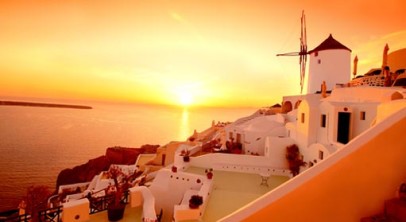Mediterranean Odyssey aboard Saga Pearl II

1 Southampton, England
Lying near the head of Southampton Water, a peninsula between the estuaries of the Rivers Test and Itchen, Southampton is Britain’s largest cruise port.
It has been one of England’s major ports since the Middle Ages, when it exported wool and hides from the hinterland and imported wine from Bordeaux. The city suffered heavy damage during World War Two and as a result the city centre has been extensively rebuilt.
2 La Coruña, Spain (for Santiago de Compostela)
La Coruna, Spain
The busy and proud port of La Coruña is perched on the north-western coast of Spain and is the capital city of the rugged and remote region of Galicia. Boasting a long maritime lineage, La Coruña is famous for being the departure point for Felipe II’s doomed Armada, which was defeated by the English in 1588.
It is also the final resting place of the British general, Sir John Moore. In keeping with its seafaring tradition, the port is also famous for the Torre de Hercules, Europe’s oldest functioning lighthouse.
The town itself is a pleasing mixture of handsome squares, impressive Romanesque churches and some of the most well-preserved 12th-century buildings in the region.
3 Cartagena, Spain
Cartagena, Spain
A Mediterranean city and naval station located in the Region of Murcia, southeastern Spain, Cartagena has been the capital of the Spanish Navy’s Maritime Department of the Mediterranean since the arrival of the Spanish Bourbons in the eighteenth century.
As far back as the sixteenth century it was one of the most important naval ports in Spain, together with Ferrol in the North.
It is a walled town and has a fine harbour defended by forts. In the time of Philip II of Spain, it was a major naval seaport of Spain and is still the main military haven of the country.
4 Palma, Majorca
Palma
Set on the south coast of Majorca, Palma is the capital of the Balearic Islands. A vibrant city deservedly fitting its status, it has nonetheless managed to retain much of its traditional charm and culture.
Past settlers have left their mark on Palma and this is evident as you stroll around the city, particularly in sights such as the Arab baths and the Almudaina Palace. Indeed, the Balearic capital has a wealth of attractions, including the Bellver Castle which has dominated the skyline since the 14th century. But this is outclassed by the cathedral, a Gothic masterpiece which in its present form took almost 400 years to complete.
Undoubtedly one of Palma’s best features is the main promenade of Passeig d’es Born that is lined with plane trees and adorned with flowers. If you want to seek a little solace from city life, the beautiful Parc de Mar is built on several levels and its focal points are a man-made lake and a colourful mural by Joan Miro, one of the park’s designers.
It is not just history that gives Palma its charm. It is also a cultural centre and plays host to numerous concerts, while its variety of restaurants and multitude of bars mean there is always somewhere to relax and savour the special atmosphere of the city.
5 Syracuse, Sicily
Stracuse
Syracuse is your introduction to Sicily, an island of breathtaking scenery and rich history. Ancient Syracuse is like an island in itself, separated from the rest of Sicily by a narrow channel.
You can step back through the centuries in Ortigia, the cultural heart of the old city, which the Roman consul Cicero famously described as the most beautiful in the world.
On the western edge of Syracuse lies the Archaeological Park, where you can see an array of important historical sites, or you could also visit the Catacombs of San Giovanni and the famous wine farm Case del Feudo.
6 Piraeus (for Athens), Greece
Athens, Greece
Piraeus Port is the harbour of Athens, the biggest commercial port in Europe and third-largest in the world. Situated on a promontory on the edge of the Saronic Gulf, it occupies an important strategic position for Athens’ defences.
The port first gained importance in around 482BC, when military strategist Themistocles persuaded the Athenian government to fortify the harbour. The port was used as a navy base for the powerful Athenian fleet, but after the collapse of the Greek empire it fell into disrepair until the founding of modern Greece in 1832.
Since then, the area has grown in importance and it is now a major centre for European shipping. As archaeological finds are slowly being uncovered within the city, visitors are now able to study ancient methods of ship building which took place in the port.
7 Santorini, Greece
Santorini
Dramatic sheer cliffs mark your arrival at Santorini in the Cyclades. The island has an ancient history dating from the Minoan civilisation but its most notable epoch was 3,550 years ago when a volcanic eruption transformed the landscape into one of black-sand beaches, towering outcrops and an enormous, now-flooded, caldera (crater).
In this stark landscape, rustic villages of dazzling whitewashed houses and simple domed churches present the archetypal image of a Greek island.
8 Marmaris, Turkey
marmaris
Marmaris was part of the Carian Empire in the 6th century B.C. The old quarter of town comes to life with bustling bazaars and popular restaurants.
Perhaps visit the ancient harbour city of Caunos where its mixture of cultures can be seen throughout the ruins of its various archaeological remains: the Carian city wall, the Lycian and Carian tombs, the medieval walls on the acropolis, a Roman fountain and baths, a theatre dating back to the 2nd century BC and a Byzantine basilica.
9 Limassol, Cyprus
Limassol, Cyprus
Cyprus has been shaped by over ten thousand years of history. Various civilisations have come to the island over the centuries, enticed by its geographical position, wonderful climate and wealth of copper deposits – the name Cyprus actually comes from the Greek word for copper, ‘Kypros’.
The sunny resort of Limassol is one of the largest towns on the island, lying in the heart of the wine country. Along with a far-reaching sandy beach, there is a fine selection of restaurants and tavernas.
Limassol is renowned as the home of Commandaria, the oldest known named wine, and it is also a fortification, based where the Limassol Medieval Castle stands today, the place where Richard the Lionheart married Berengaria of Navarro before crowning her Queen of England.
For those interested in art, Limassol has a Folk Art museum and a modern Municipal Art Gallery, as well as an Archaelogical Museum.
10 Haifa (for Jerusalem), Israel
Haifa
This busy working port and UNESCO World Heritage Site is Israel’s third largest city and has been known as a safe haven for ships since the 2nd century. Built on the slopes of Mount Carmel it has a long, fascinating history dating back to Biblical times. Jews and Arabs live in harmony here and the city’s most recognisable landmark is the dome of the Bahá’í shrine, which advocates a common world language and religion. This is a wonderful city to visit with its mix of architectural styles, fabulous museums, pavement cafes and parks.
From here you can discover the awe-inspiring treasures of the Holy City of Jerusalem, where King David established the capital of the ancient Israelites 3,000 years ago, where King Solomon built his resplendent temple, where Muslims believe the prophet Mohammed ascended to heaven and where Christians believe Christ was sentenced to death. You can also visit medieval Acre, and join a full day excursion to Nazareth and legendary Galilee, which covers some of the most important sites associated with Jesus’ life.
11 Ashdod (for Jerusalem), Israel
Ashdod
The Port of Ashdod is one of Israel’s largest ports. The city is the sixth-largest city in Israel.
Ashdod has a long history, and was inhabited in the times of the Bible by the Philistines. When the Philistines captured the Ark of the Covenant from the Israelites, they brought it here before being forced to return it. However, few traces remains nowadays of the ancient city.
Ashdod is ideally located for trips to Jerusalem, one of the most revered cities on the planet for Jews, Christians and Muslims alike. Here, attractions range from religious buildings, emblems and archaeological relics, including the famous Wailing Wall.
12 Port Said (for Cairo), Egypt
The Pyramids of Giza
Lying at the entrance to the Suez Canal, the modern port and city of Port Said originally served as a 19th century working camp for canal workers. The city suffered considerably during the Suez Crisis and subsequent wars but today, after extensive rebuilding, is an important port and fuelling station. It is home to many original wooden houses on Sharia Gumhuriya and has a good Military Museum which features war artefacts from ancient times to modern day. Serving as the gateway to Cairo, you can visit the mighty Pyramids of Giza, the mysterious Sphinx and the famous Egyptian Museum which houses the artefacts found in Tutankhamen’s tomb.
13 Alexandria, Egypt
Alexandria
The second largest city and the main port of Egypt, Alexandria has been popular with tourists for decades, its cool Mediterranean breezes offering a refuge from the searing summer heat. Alexandria was built in the third century BC by the Greek architect Dinocrates, by orders of Alexander the Great, who vaingloriously named it after himself. Alexandria flourished as a cultural, intellectual, political and economic city, the remains of which have kept archaeologists enthralled for years. Recent discoveries include a colossal Ptolemaic statue, inscribed obelisks and over 20 stone sphinxes, all dredged from the eastern harbour, where they had been submerged for centuries following a series of earthquakes. Alexandria is also home to ancient catacombs, Pompeii’s Pillar and is the site of the great Pharos lighthouse, once one of the seven wonders of the ancient world.
14 Benghazi, Libya
Cyrene
Benghazi was founded by the ancient Greeks in 6BC and ruled successively by the Turks, Italians and the British. Libya’s second city gained its independence in 1951 and was briefly the provisional capital for the National Transition Council during the Arab Spring. There are Greek ruins at both Ptolemis and Cyrene worth visiting.
15 Al Khums (for Leptis), Magna Libya
Leptis Magna
An undoubted hightlight of your cruise must be UNESCO World Heritage site Leptis Magna. One of the best-preserved cities of the Roman Empire, Leptis Magna is renowned for some of the finest Roman ruins in existence today such as Hadrian’s Baths, the Palestra and the 16,000 seat amphitheatre.
16 Tripoli, Libya
Tripoli
Tripoli was formed in the 3rd century BC when three cities united and it was formerly an important Phoenician city. Capital of Libya, it is a busy seaport and industrial centre with a rich history and a busy medina with bazaars and mosques.
The second-century AD Arch of Aurelius is a legacy from the Romans, and Tripoli is well situated for exploring some of the country’s fascinating archaeological sites including the UNESCO World Heritage sites of Leptis Magna and Sabratha.
Please note: American and Swiss nationals will not be able to go ashore under any circumstances, nor will any passengers with an Israeli passport or a passport containing a valid or expired Israeli visa. Passengers may only go ashore on an organised excursion or booked on the provided shuttle service into the city centre. Please note all tours are subject to minimum numbers in order to run.
17 Valletta, Malta
Valletta, Malta
Malta’s capital city was built by the Knights of St John in 1565 and named after the French Grand Master of the Order, La Vallette. It is a great place to explore on foot as it’s full of historical sights and many shops, cafés and restaurants. St John’s Co-Cathedral is certainly worth a visit, its resplendent interior making it one of Malta’s most important treasures.
The city itself is a masterpiece of baroque architecture with narrow streets leading to pretty courtyards, and with fountains and statues dotted throughout, including Republic Square’s monument to Queen Victoria, an echo of British Imperial influence on the island. The Grand Harbour, one of the world’s deepest natural harbours, adds to Valletta’s charm and mystique.
Please note: The ship’s berth is at the bottom of a steep hill so you will need to walk uphill or take a taxi into the centre of Valletta. Current regulations prohibit tour vehicles from re-entering the port, which means you will be required to walk a maximum of 500 yards back to the ship.
18 Tunis, Tunisia
Tunis
Capital of Tunisia, the city of Tunis exudes a distinctly European atmosphere evident in the French colonial architecture, while its enthralling history and traditions come alive with visits to the colourful souks and markets, ancient remains and the vibrant medina, now a UNESCO World Heritage Site.
Nearby, the remains of the ancient city of Carthage reveal an incredible history that incorporates the rule of the Phoenicians and its status as the third largest city within the Roman Empire. Perhaps travel further afield to Dougga, the largest and most spectacular Roman site in Tunisia.
19 Gibraltar
Gibraltar
Tagged on to the end of Iberia, the intriguing British outpost of Gibraltar is dominated by a sandy peninsula and the stunning 1,400-feet-high limestone Rock. Although small, Gibraltar has always been seen as having great strategic importance on account of its advantageous position where the Atlantic meets the Mediterranean, just 12 miles from the coast of Africa.
Ever popular with British holidaymakers, Gibraltar is very much a home from home, boasting excellent duty-free shopping in many familiar British high street shops.
Please note: All coaches in Gibraltar are smaller 22-seat vehicles and are accompanied by a driver/guide. Due to new health and safety regulations scooters/wheelchairs and walking frames are not allowed on any of the vehicles under any circumstances.
20 Vigo, Spain
Vigo
Dating from Roman times, the Galician city of Vigo is home to a fine natural harbour. It was in this calm, fjord-like quay that the English and Dutch defeated the French and Spanish fleets in 1702.
Today, the attractive marinas stand in contrast to the industrialised areas of the city, while further exploration will reveal the characteristic 17th-century architecture and attractive countryside beyond. The charming Old Town is a delight, with its labyrinth of winding narrow streets and shady squares.
Nearby is Santiago de Compostela, one of Christendom’s most holy pilgrimage shrines, where a vast Gothic cathedral reputedly houses the body of St James the Apostle.
21 Southampton, England
Lying near the head of Southampton Water, a peninsula between the estuaries of the Rivers Test and Itchen, Southampton is Britain’s largest cruise port.
It has been one of England’s major ports since the Middle Ages, when it exported wool and hides from the hinterland and imported wine from Bordeaux. The city suffered heavy damage during World War Two and as a result the city centre has been extensively rebuilt.
 Titan Travel have a reputation for innovative and enthralling escorted holiday itineraries, and through the guidance of their founding principles, “quality, service and value” which have remained unchanged since the 1970′s, their expertise and experience are second to none.
Titan Travel have a reputation for innovative and enthralling escorted holiday itineraries, and through the guidance of their founding principles, “quality, service and value” which have remained unchanged since the 1970′s, their expertise and experience are second to none.
Titan Travel strive to ensure that aspect of their holidays whispers quality, before you fly, you get to appreciate a comfortable, chauffeur-driven transfer from your front door to the airport with our peerless VIP Home Departure Service, check-in assistance and complimentary porterage. All international flights are with world-renowned scheduled airlines and cruises with acclaimed operators. Touring holidays are expertly designed by the product team to present a comprehensive, imaginative introduction to the destination of choice yet still offer plenty of time for relaxation. The services of a tour manager or cruise manager are included throughout. When you return to the UK, you are met in the arrivals hall of the airport and shown to your VIP Home Departure Service vehicle, waiting to return you to your front door.
Our Opinion
“Titan Travel’s guiding principles of customer service, quality of product and value for money are undoubtedly a contributing factor to them being voted, on many occasions, the UK’s best tour operator.”

